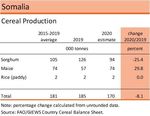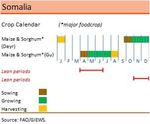GIEWS Country Brief Somalia - ReliefWeb
←
→
Page content transcription
If your browser does not render page correctly, please read the page content below
GIEWS Country Brief
Somalia
Reference Date: 09-July-2021
FOOD SECURITY SNAPSHOT
• Production of 2021 “Gu” main season cereals
forecast at 20-40 percent below average due to
unfavourable seasonal rains
• Below-average cereal output gathered in 2020
• Severe pasture and water shortages in pastoral
areas affecting livestock conditions
• Prices of domestically produced cereals increased in
recent months
• Sharply deteriorating food security situation due to
two consecutive poor rainy seasons, with 2.7 to
2.8 million people estimated to be severely food
insecure between April and September 2021
Unfavourable prospects for upcoming 2021
“Gu” season harvest
In central and southern agro-pastoral areas, seasonal rains
established in late April, with about one month of delay, affecting
planting and germination of the “Gu” season crops, to be
harvested in July and accounting for about 60 percent of the
country's total annual cereal output. Above-average precipitation
amounts in early May benefited crops, but also triggered floods
that resulted in localized crop losses and displaced more than
400 000 people. Subsequently, only scattered, below-average
showers were received and seasonal rains had an early
cessation in late May. Dry weather conditions affected the rainfed
cropping areas as well as irrigated crops in riverine areas along
the Juba and Shabelle rivers, as low river water levels negatively
impacted irrigation activities. Poor and erratic seasonal rains
severely affected the area planted and yields in the main
producing areas, including the key maize producing Lower
Shabelle Region, the “sorghum belt” of Bay Region and the
"cowpea belt" in Middle Shabelle, Galgadud and Mudug regions.
According to the preliminary forecast by the FAO Food Security
and Nutrition Analysis Unit (FSNAU) and the Famine Early
Warning Systems Network (FEWS NET), the 2021 “Gu” output is
expected to be 20-40 percent below the average.
Since mid-2019, the country has been facing a severe desert
locust upsurge. During 2019 and most of 2020, swarms were
present mainly in northern and central agro-pastoral areas.
Widespread damages to pastures have been averted and losses,
although significant, occurred only in some localized areas due to
large-scale control operations carried out by the government with
the support of FAO. In late 2020, some swarms moved to
GIEWS global information and early warning system on food and agriculturesouthern key cropping areas, where they caused localized losses of “Deyr” crops. Infestation levels have been declining in 2021 as a result of sustained control operations and poor rains between October 2020 and April 2021, which created an adverse environment for insect reproduction. However, above-average rains in early May allowed the remaining swarms to mature rapidly and lay eggs in northern areas. Despite the formation of a new generation of locusts in June, control operations, coupled with the early migration of some immature swarms to summer breeding areas in northern Ethiopia, resulted in a substantial decline of swarms. Although current infestation levels are significantly lower compared to one year ago, monitoring and control operations must be maintained to further reduce migration and breeding during the summer. Below-average cereal output gathered in 2020 Harvesting of the secondary 2020/21 “Deyr” season crops was concluded last January, while the off-season harvest was gathered in March. The October-December 2020 rains were characterized by early season dryness, which affected crop establishment and development. Heavy rains in late October and early November lifted crop prospects, but triggered floods and caused localized production shortfalls. As a result of the erratic seasonal rains and of localized losses due to locusts, cereal production is estimated at about 78 000 tonnes, 8 percent below the average. The minor “Karan” crops, gathered in November in northwestern areas, were affected by poor rains, desert locust infestations and insecurity, and production was estimated at about 17 000 tonnes, about 20 percent below average. The major “Gu” crops, gathered in July 2020 in central and southern areas, were affected by widespread floods by the early cessation of seasonal rains and by insecurity. As a result, cereal production is estimated at 73 000 tonnes, about 30 percent below average. The 2020 aggregate cereal production is estimated at about 170 000 tonnes, 13 percent lower than the average of the previous five years. Severe pasture and water shortages in pastoral areas affecting livestock conditions Southern agro-pastoral areas and central-northern pastoral areas have been affected by two consecutive poor rainy seasons since October 2020. Most of these regions remained almost completely dry until late April. Severe rainfall deficits and localized pasture losses due to locusts resulted in the deterioration of rangeland conditions to poor levels (Vegetation Health Index map). Severe shortages of pasture and water led to widespread animal emaciation, adversely affecting also livestock births and milk production. In addition, drought-induced livestock diseases, abortions and deaths were reported in Woqooyi Galbeed and Sanaag regions in the north, Mudug and Galgaduud regions in the centre, Hiran and Gedo in the south. In these areas, herders that were unable to provide adequate feed and water to their animals opted to cull the new-born calves in order to save the milk-producing females. Livestock deaths and low birth rates have resulted in the reduction of herd sizes, which is of particular concern as livestock numbers were already at well below-average levels in northern and central regions due to the massive losses induced by the 2016/17 drought. Abundant rains in early May had a positive impact on rangeland and livestock conditions, but triggered floods which caused some livestock GIEWS global information and early warning system on food and agriculture
deaths, especially in the northwestern Togdheer Region. However, these limited improvements have been short-lived as only few scattered, below-average showers were received for the remainder of the month and seasonal rains had an early cessation in late May. As a result, rangeland resources entered the current “Hagaa” dry season at well below-average levels. Prices of domestically produced cereals increased in recent months Prices of locally produced maize and sorghum increased in most markets, including the capital, Mogadishu, by 10-25 percent between January and May, following seasonal patterns. Prices in May were around the high levels of one year earlier, due to a below-average cereal production in 2020. By contrast, prices of imported rice were mostly stable in recent months around their year-earlier levels. Between January and May 2021, prices of livestock increased in most markets, mainly due to increased demand for Ramadan/Eid festivities and the reduced supply of saleable animals with good body conditions following dry weather conditions since late 2020. For example, prices of goats increased by about 10 percent over this period in Burao market, one of the main livestock markets in the Horn of Africa. As prices of imported rice, the main staple in pastoral areas, have been stable, the terms of trade for pastoralists have slightly improved, with the equivalent in rice of a goat increasing from 90 kg in January 2021 to 100 kg in May 2021. However, as pastoralists have to repopulate their herds and market activity is low, it is unlikely that the more favourable terms of trade will determine a concrete improvement in terms of access to food among the poor pastoral households who own few livestock. Food insecurity sharply deteriorating in 2021 Two consecutive poor rainy seasons resulted in significant crop and livestock production shortfalls, while food access has been severely affected in recent months by declining employment opportunities in rural areas and by the escalation of conflict. According to the latest FSNAU/FEWS NET analysis, 2.7 to 2.8 million people (more than 20 percent of the total population) are estimated to be severely food insecure (IPC Phase 3: “Crisis” and IPC Phase 4: “Emergency”) between April and September 2021. Phase 3: “Crisis” levels of food insecurity are estimated to prevail in most of the country through September 2021. Disclaimer: The designations employed and the presentation of material in this information product do not imply the expression of any opinion whatsoever on the part of FAO concerning the legal status of any country, territory, city or area or of its authorities, or concerning the delimitation of its frontiers or boundaries. GIEWS global information and early warning system on food and agriculture
You can also read






















































